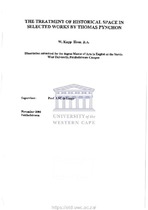| dc.description.abstract | The focus on space and spatiality is relatively new in literary studies and also not unproblematic. Problems arise from the way in which these concepts are constructed, described, defined and interpret~. It is possible to derive numerous kinds of space, such as historical space, physical space, metaphysical space and religious space, to name a few, from the structure or thematics of a novel. This in itself presents a problem, since the literary scholar must differentiate between these spaces in order to determine which will be most useful for study of a particular aspect. There does not seem to be a coherent theoretical position in literary scholar regarding space, and thus various views of theorists will be considered. Gullon (1975:21), in a seminal article on space entitled On Space in the Novel provides a possible definition of space, with reference to another seminal article, this time by Joseph Frank when he states that "Frank calls 'spatial' the form of those works that at a given instant in time concentrate actions that can be perceived, but not related, simultaneously". This definition denotes a further complication engendered by space, namely the notion that different spaces intersect and interrelate with each other, and consequently that it is very difficult - if not impossible - to separate the various kinds of literary spaces in order to analyse the occurrence of a single space in a text. It also seems bound to time, but in a sense bridges the temporal gaps in a novel since it brings together parts that are not necessarily adjacent to each other temporally. Time becomes spatialized by treating events in the novel as separate chunks which can be rearranged and linked to each other. 1bis creates a more coherent and comprehensive picture of events in a text. namely the notion that different spaces intersect and interrelate with each other, and consequently that it is very difficult - if not impossible - to separate the various kinds
of literary spaces in order to analyse the occurrence of a single space in a text. The main point in this regard seems to be creating patterns. This brings together more elements for the reader to be viewed at once, allowing him or her to attain a broader perspective on the text. | en_US |

